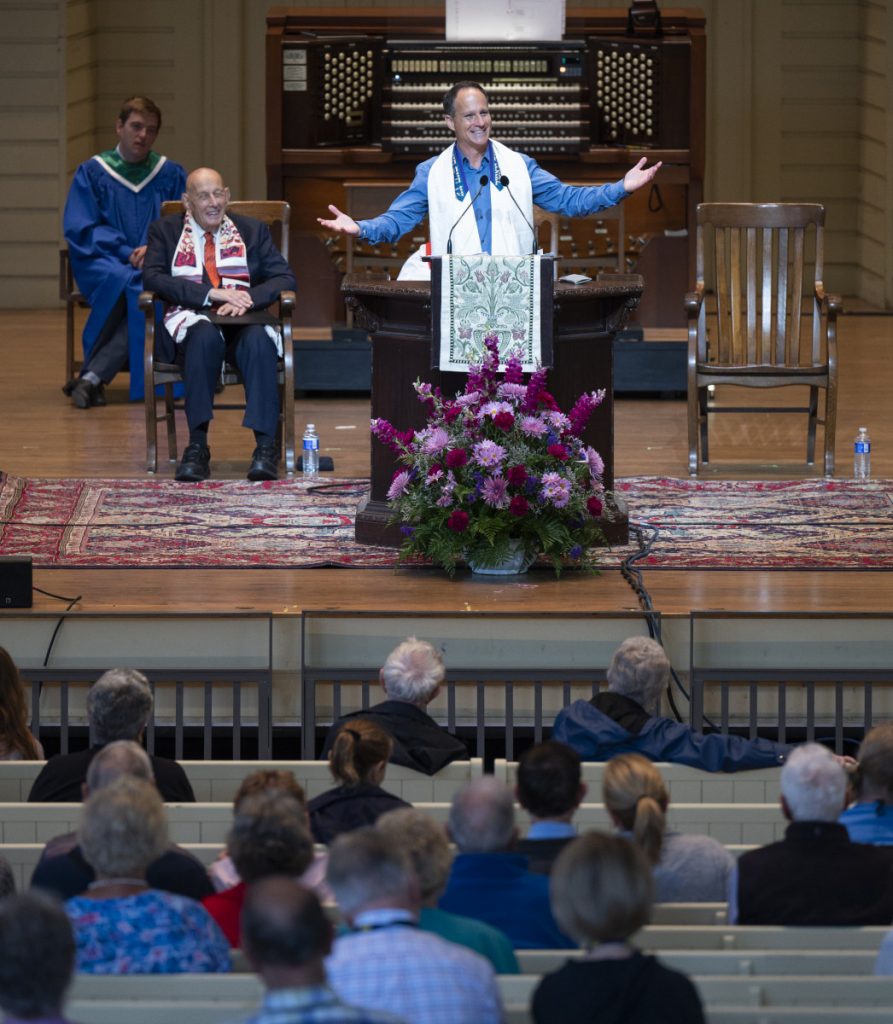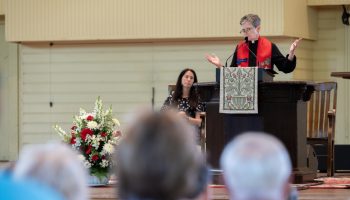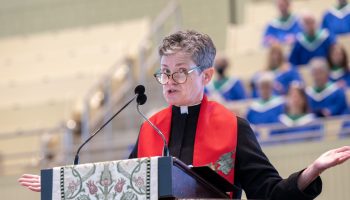MARY LEE TALBOT – STAFF WRITER

“For six days the rabbi preached, and on the seventh day the rabbi rested,” said Rabbi Jonah Dov Pesner at the 9 a.m. Friday, July 16 worship service in the Amphitheater. “I will conclude my day here and drive home with my family to be home before the Sabbath begins.”
Pesner’s sermon title was “Where Do We Go from Here? Remember the Sabbath and Make it Holy.” The scripture text was Exodus 20:8, read in Hebrew and English.
“Shabbat embodies all that is good and great about Judaism,” he said. “In the Ten Commandments, God told the Israelites to make the sabbath holy by not working. It was a day of rest for all people and for animals. For six days God created, and then rested on the seventh day and blessed it.”
In his book The Sabbath, Rabbi Abraham Joshua Heschel taught that Jews do not build cathedrals into space, but build cathedrals in time.
“Jews sanctify the moments, the seasons, the time, the calendar,” Pesner said. “We pray three times a day, in the morning and the evening, when we eat, dance, study and sing, we are praying and sanctifying moments in time.”
God made stuff, he said, and then stepped back to contemplate the stuff — and said “this is good.”
Because Jews celebrate time rather than space, the sabbath is holiness and the eternal in time. “We turn from the world of creation to the creation of the world,” Pesner said.
Chautauqua was designed for sabbath, Pesner said. “We go from devotions, for a walk by the lake, come back to a lecture, sing, dance, eat. This is what Rabbi Heschel had in mind.”
Pesner said, “We have to make space for Shabbat in our lives. Every Friday the family gathers, bakes the challah, lights the candles for remembrance of the Sabbath and protection of the Sabbath. We share the ‘oyes and joys,’ break the challah, drink the wine and eat. It is Shabbat that has kept the Jews together.” He urged the non-Jews in the congregation to “make shabbos” in their own way.
During his week as chaplain, Pesner urged the congregation to hear the voice of the prophets to action in a broken world. “We never forget the broken world. When we drink the wine, we thank God for the wine and for leading us out of Egypt. We remember we were slaves, and there is no day of rest for slaves. We are called to action to remember those enslaved.”
Shabbat is also a time to remember the earth and that all God’s creatures need rest.
Pesner said, “The Midrash says that after God created the world, God took the first human for a walk in the garden, ‘Appreciate it and notice it,’ God said. ‘There will not be another world if you destroy this one.’ ”
Rabbi Heschel said that prayer was a call to get to work. He called his time in Selma, Alabama, marching with the Rev. Martin Luther King Jr., “praying with legs.” Heschel also said that prayer is useless unless it is subversive; unless it overthrows the forces that oppress.
“We say thank you to the creator for trusting us to take care of creation,” Pesner told the congregation. “We pray for the ‘olam habach,’ the world to come. This world will come at the end of time, when the broken world will be repaired and there will be holiness, blessing, joy and the world will be at peace. It will be one long Shabbat.”
There is a legend that the people of Israel asked God, “What is the reward for doing well?” God answered “Shabbat.” They asked, “What is the proof for doing well, how can we taste it so we see peace in the world to come?” God said, “Observe Shabbat.”
Pesner said, “Shabbat is a liminal space between brokenness and perfection and back. We move to what is possible and then back to what is.”
Jews sanctify the moments, the seasons, the time, the calendar. We pray three times a day, in the morning and the evening, when we eat, dance, study and sing, we are praying and sanctifying moments in time.”
– Rabbi Jonah Pesner
When Joseph Kanfer was trying to market Purell, he consulted a social psychologist who told him the mouth of the cave was the transition point between safety and danger, and then from awareness of the outside world to what might lurk in the cave. The psychologist said to put Purell at doorways and people will use it.
The Kabbalistic rabbis would gather on the eve of the Sabbath dressed in white. Pesner stepped from behind the pulpit to show his white shirt and slacks.
“The rabbis would gather to experience the mystical union of the bride, the Sabbath, with the groom, the Holy One,” he said. “They gathered to celebrate the wholeness and mystical unity. Although it is an overused phrase, this is the ‘tikkun olam,’ the repair of the world.”
Pesner continued, “The mystics imagined that in the beginning was only God and only perfection. God was alone and was unhappy about that. So God contracted to make space for creation and in contracting left room for imperfection. Perfection contracted to a space so small, the bottle it was in shattered and all the shards of perfection spread throughout the universe. Our job is to gather one shard at a time to bring them back on Shabbat.”
When the Sabbath ends, there is another time of prayer on Saturday night to say farewell to the Sabbath and pray for its return.
The first Friday night after Pesner and his wife spent a year in Jerusalem, they were in Paris. After a day of sightseeing, they planned to go to a certain synagogue for services and for Pesner to say the mourning kiddush because it was the anniversary of his father’s death.
They had hurried all over Paris and, in the day with only paper maps, they wandered far away from their hotel and where they wanted to worship. As they walked, they heard the music of the opening song to welcome the Sabbath and found themselves near a synagogue where they were welcomed in their T-shirts and jeans, and they kept the day holy.
“I love to be a Jew and to do what I do, and I would love to have you all come over for Shabbat dinner,” he told the congregation. “Maybe we can do that sometime.”
The Israelites needed the freedom of a Shabbat to leave slavery behind them. When they got to the Red Sea, they were blocked by the water in front of them and the Egyptian army behind them. The people screamed at God, “Did you bring us all this way to get stuck?”
Midrash says that Moses was praying. God said, “Do something, don’t just pray.” One person, Nahshon, entered the water with courage and strength. Even God was watching. Nahshon’s courage was rewarded.
“Anyone can be a Nahshon,” Pesner said. “We have to act with faith and courage to part the seas. But there is another interpretation. It wasn’t when Nahshon entered the water, but when everyone entered, that the seas parted.”
Pesner asked the congregation to stand and hold hands. He blessed the congregation, saying, “May God bless you and keep you. May God’s radiance shine on you and be kind to you. May you be hand in hand with the Holy One, a partner in ‘tikkun olam,’ and may you know peace.”
The Rev. John Morgan presided. Arthur Salz, co-author of Shalom Chautauqua: The Hebrew Congregation and the Jewish Presence, read the Scripture. Joshua Stafford, who holds the Jared Jacobsen Chair for the Organist and is the director of sacred music, played “Sarabande,” by Joseph Sulzer, as the prelude. For the anthem, members of the Motet Choir sang “Peace at the Last,” music by Gregory Norton, words from the Book of Common Prayer. The postlude was “Toccata” from Symphony No. 5 by Charles-Marie Widor. The Robert D. Campbell Memorial Chaplaincy provided support for this week’s services and chaplain.




